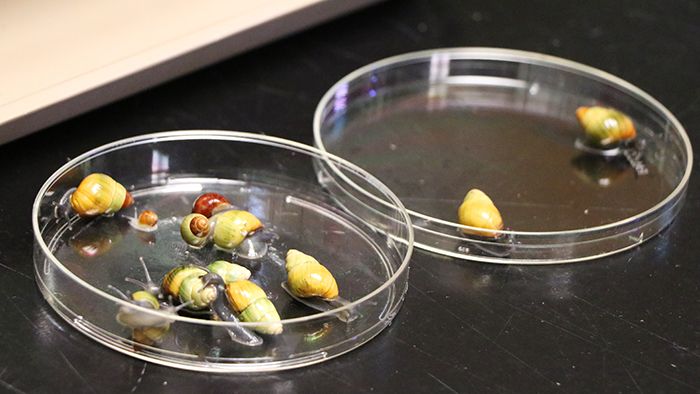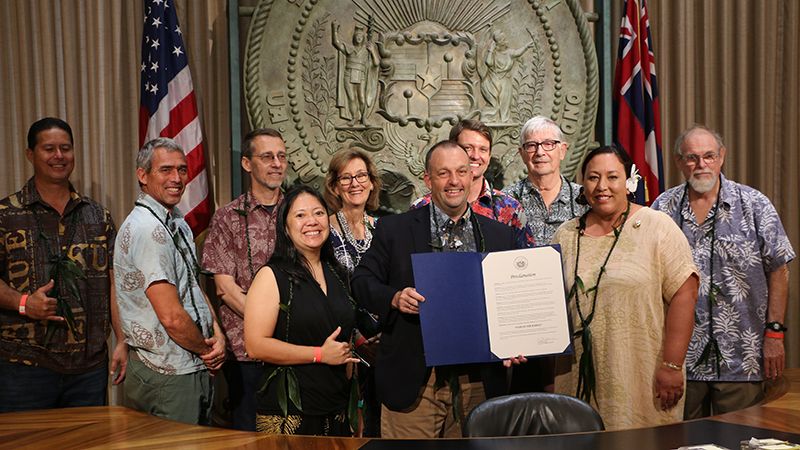HONOLULU — Gov. Josh Green recently issued a proclamation declaring 2023 the Year of the Kahuli. Once inhabiting nearly every ecosystem in the Hawaiian Islands, kahuli, or native tree snails, play an important role in nature and Native Hawaiian culture. They are revered in Hawaiian cultural history and are considered “jewels of the forest.”
“I’m visited today by some of the frontline warriors in the efforts to save kahuli. A fundamental part of what makes Hawaii so special is the environment around us,” stated Gov. Green at the proclamation signing. “Many of our plants and animals were here long before people, and that includes our kahuli and this is why it’s so important to do everything we can to save them.”
Kahuli once had a population of 750 different species existing only in the state for over millions of years. However, nearly half have become extinct. Like many native species, they are threatened by climate change, as well as predators such as rats and cats, introduced invasive snails, chameleons, and human encroachment. Of the remaining land snails, approximately 100 species will face extinction within the next decade without increased research and conservation action.
Dr. David Sischo of the Department of Land and Natural Resources’ Division of Forestry and Wildlife operates a lab home to 40 species of rare native snails from five islands. All are fed and kept safe until they can return to their forest homes. It’s a slow process.
“We think of the lab as an emergency room for snails that are on the very brink of extinction,” explained Sischo in a DLNR news release. “We take really good care of them, increase their numbers, and then put them back out on the landscape in protected areas.”

According to Sischo, certain species have an average life span of 20 years, taking five years to reach maturity. They only produce one to five offspring each year. In order to even consider releasing them into the wild, a population needs to be in the hundreds, getting past what Sischo calls the “danger zone” where they’re on the very brink of extinction. Last year, more than 7,000 snails from the DOFAW lab, the Bishop Museum and Honolulu Zoo — who are also raising snails — were released.
Sischo explains there are no native snails that eat plants in Hawaii. Similar to earthworms, they eat algae, fungus and bacteria that grow on plant surfaces or they eat dead and decaying leaves. “Our native snails are really important components of healthy forest ecosystems. They’re cleaning the plants, they are decomposing leaf litter, turning nutrients over … they’re important for forest health,” he said.
Snails are known as “the canary in the coal mine” of a Hawaiian forest. “They’re very sensitive to environmental degradation,” said Sischo. “When they go, it’s usually an early warning sign that there’s more catastrophic things to come. … You can be sure other species of plants and animals are not far behind.”
DLNR First Deputy Laura Kaakua explained, “In Hawaiian traditions, snails sing. Kahuli are featured in our stories, hula and chants, and they represent voice in Hawaiian culture. We don’t hear the kāhuli anymore, but perhaps we could with a widespread effort to protect and steward our native forests.”
The Year of the Kahuli will be celebrated with outreach activities, art contests and more, including the film debut of “Kahuli,” in April, a special brew from Honolulu Beerworks called Kahuli Brewli also debuting in April, and the second annual Kahuli Festival at Bishop Museum in September.
Sarah Yamanaka covers events, environmental and community news for Spectrum News Hawaii. She can be reached at sarah.yamanaka@charter.com.





